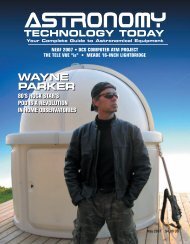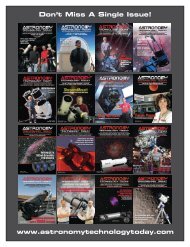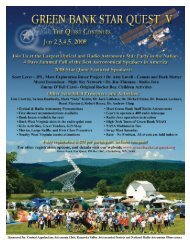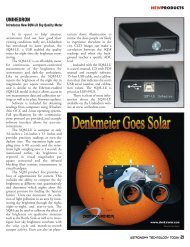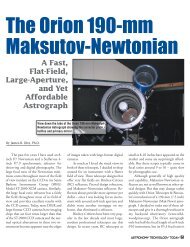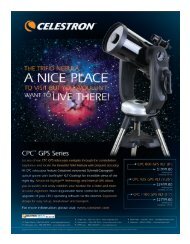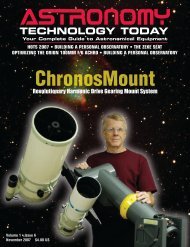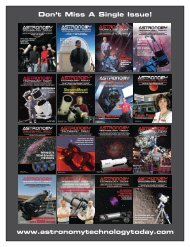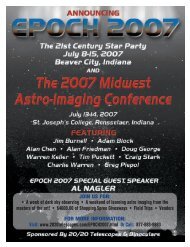iOPTRON - Astronomy Technology Today
iOPTRON - Astronomy Technology Today
iOPTRON - Astronomy Technology Today
You also want an ePaper? Increase the reach of your titles
YUMPU automatically turns print PDFs into web optimized ePapers that Google loves.
A HOT TOPIC - ACTIVE COOLING OF A PRIMARY TELESCOPE MIRROR<br />
Figure 17: The active cooling system is shown in use, pre-cooling the 36-inch primary mirror<br />
to the desired temperature.<br />
become a more automated system. But, for<br />
now, a manual system is fine.<br />
Regarding dew point, the NOAA<br />
website has very detailed hourly forecasts<br />
for anywhere in the U.S. (http://www.<br />
wrh.noaa.gov/psr/). Type in your location<br />
and press enter, then click on the map as<br />
close as you can to your observing spot. Towards<br />
the lower right of the page that<br />
opens, you’ll find the “Hourly Weather<br />
Graph” (Figure 13). Click on it, and it will<br />
enlarge.<br />
After using this site for the last year, I<br />
find it rather accurate. The winds die down<br />
about when it forecasts, and temperatures<br />
and dew points match too. For this mirrorcooling<br />
system, knowing dew point is critical.<br />
You don’t want to pre-cool the mirror<br />
to the temperature predicted for 11 p.m.<br />
when the present dew point happens to be<br />
above that temperature. I prefer to keep the<br />
pre-cool set-point at least 10°F above the<br />
dew point. Anything closer, and it may be<br />
raining soon anyhow. At my observing site<br />
in northern Arizona, which is considered an<br />
“elevated desert” at 7000 feet (with cactus<br />
too!), I’ve seen 9-percent humidity and -<br />
20°F dew points when the actual temperature<br />
is 70°F and expected 11-p.m.<br />
temperature was 40°F, but during our<br />
Monsoon Season in July and August, humidity<br />
is a problem. As with any telescope,<br />
“first, do no harm.”<br />
A recent addition is the use of 4-inch<br />
cam-lock quick-disconnects for the hoses<br />
(Figure 14). These give the Cool Breeze II<br />
system that “NASA” look, but really speed<br />
things up by allowing disconnection of the<br />
hoses from the mirror cover when removing<br />
it from the scope. Notice the color coding<br />
rings on connections and hoses (Figure 15).<br />
The cold and warm return ports have<br />
been reversed from the original configuration,<br />
with the cold-air inlet now porting to<br />
the “bottom” of the mirror box. This is not<br />
a problem for the system as fans mounted<br />
in the mirror box move the air around the<br />
primary, but in this configuration the spot<br />
on the mirror box wall to which the cold-air<br />
inlet points is now below the mirror. Previously,<br />
the cold-air inlet was on top, bathing<br />
the mirror from top to bottom and also<br />
forming a frost patch on the mirror box wall<br />
right above the mirror. Um, yeah, it melted,<br />
and during the fourth use of the system two<br />
long drips on the mirror were the result.<br />
With the switch of the hoses, that won’t<br />
happen again. With the cold-air inlet on<br />
bottom side of the mirror cover, any frost<br />
patch forms below the mirror, not above it<br />
Figure 16.<br />
The system works great – better than I<br />
expected, actually. The primary mirror cools<br />
inside the telescope while still covered by<br />
the roll-off observatory, waiting for Sunset,<br />
and the mirror is at temperature, ready for<br />
observing, when we are. In Figure 17, the<br />
Sun has set, and the observatory building<br />
has been rolled away from the telescope,<br />
clearing the 32-foot diameter of the block<br />
patio on which I roll the observing<br />
ladder from position to position. When<br />
not attached to the telescope, the mirror<br />
cover is placed on the wheeled cart that<br />
carries the air conditioner, and the hoses are<br />
draped on top of it. Then, I simply roll<br />
the whole assembly to a portion of patio<br />
block that’s not within the turning radius of<br />
the telescope.<br />
Professional telescopes use active cooling,<br />
why not yours?<br />
Telescope Accessories & Hardware<br />
FEATURING ITEMS FROM:<br />
TeleGizmos Covers - Astrozap Dew Shields<br />
Dew-Not Dew Heaters - Peterson Engineering<br />
Antares - Telrad - Rigel Systems - Sky Spot<br />
Starbound Chairs - Smart <strong>Astronomy</strong><br />
David Chandler - Lightwedge - Baader<br />
ScopeStuff Piggyback & Balance Kits<br />
Rings, Rails, Dovetails, Cables, ATM,<br />
Eyepieces, Filters, Diagonals, Adapters<br />
Green Lasers - And MUCH more!<br />
www.scopestuff.com 512-259-9778<br />
DobStand<br />
• Only $119.99<br />
• Heavy Duty!<br />
• 1/8" Alum Tubing!<br />
• Black Anodized<br />
• Leveling Legs<br />
• Less Than 5lbs!<br />
<strong>Astronomy</strong><br />
www.astronomy-shoppe.com Shoppe<br />
<strong>Astronomy</strong> TECHNOLOGY TODAY 59



